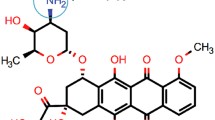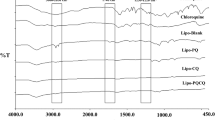Abstract
The multidrug-resistance (MDR)-reversing ability of the catamphiphilic drugs could be mediated through their interaction with the membrane phospholipids. This could lead directly (through changes in membrane permeability and fluidity) and/or indirectly (through inhibition of P-glycoprotein phosphorylation via inhibition of the phosphatidylserine-dependent protein kinase C or changes in the conformation and functioning of the membrane-integrated proteins via changes in the structure organization of the surrounding membrane bilayer) to the reversal of MDR. Using differential scanning calorimetry and NMR techniques and artificial membranes composed of phosphatidylcholine or phosphatidylserines we found a significant correlation between the MDR-reversing activity of the drugs in doxorubicin-resistant human breast carcinoma MCF-7/DOX and murine leukaemia P388/DOX tumour cells (data taken from the literature) and their ability to interact with phosphatidylserines.Trans- andcis-flupentixol were found to interact most strongly with both the phospholipids, followed by trifluoperazine, chlorpromazine, triflupromazine, flunarizine, imipramine, quinacrine and lidocaine. Differences in the interaction oftrans- andcis-flupentixol with the phospholipids studied are suggested to be responsible for their different MDR-reversing ability. Verapamil showed moderate membrane activity, assuming that the membrane interactions are not the only reason for its high MDR-reversing ability. Amiodarone showed very strong interactions with phosphatidylserines and is recommended for further MDR-reversal studies.
Similar content being viewed by others
Abbreviations
- MDR :
-
multidrug resistance
- P-gp :
-
P-glycoprotein
- PKC:
-
protein kinase C
- DSC :
-
differential scanning calorimetry
- NMR :
-
nuclear magnetic resonance
- DOX:
-
doxorubicin
- DMSO :
-
dimethylsulphoxide
- D2O2 :
-
deuterium oxide
References
Aftab D, Ballas LM, Loomis CR, Hait WN (1991) Structure-activity relationships of phenothiazines and related drugs for inhibition of protein kinase C. Mol Pharmacol 40:798–805
Alon N, Busche R, Tümmler B, Riordan JK (1991) Membrane lipids of multidrug resistance cells: chemical composition and physical state. In: Roninson IB (ed) Molecular and cellular biology of multidrug resistance in tumour cells. Plenum, New York, London, pp 263–276
Awasthi S, Sharma R, Awasthy YC, Belli JA, Frenkel P (1992) The relationship of doxorubicin binding to membrane lipids with drug resistance. Cancer Lett 63:109–116
Bates SE, Lee JS, Dickstein B, Spolyar M, Fojo AT (1993) Differential modulation of P-glycoprotein transport by protein kinase inhibition. Biochemistry 32:9156–9164
Beck WT (1991) Drug accumulation and binding in P-glycoprotein-associated multidrug resistance. In: Roninson IB (ed) Molecular and cellular biology of multidrug resistance in tumour cells. Plenum, New York, London, pp 215–228
Beck WT, Qian X (1992) Photoaffinity substrates for P-glycoprotein. Biochem Pharmacol 43:89–93
Bell RM, Burns DJ (1991) Lipid activation of protein kinase C. J Biol Chem 266:4661–4664
Blobe GC, Sachs CW, Khan WA, Fabbro D, Stabel S, Wetsel WC, Obeid LM, Fine RL, Hannun YA (1993) Selective regulation of expression of protein kinase C (PKC) isoenzymes in multidrug resistant MCF-7 cells. Functional significance of enhanced expression of PKCα. J Biol Chem 268:658–664
Boer R, Schödl A, Haas S (1994) Inhibition of rhodamine-123 efflux and modulation of rhodamine-123 accumulation in CCRF VCR-1000 cells by dexniguldipine-HCl and other chemo-sensitizers. Anti Cancer Drugs 5[Suppl 1]:20
Callaghan R, Stafford A, Epand R (1993) Increased accumulation of drugs in a multidrug resistant cell line by alteration of membrane biophysical properties. Biochim Biophys Acta 1175:277–282
Chambers T, Zheng B, Kuo JK (1992) Regulation by phorbol esters and protein kinase C inhibitors, and by protein phosphatase inhibitor (okadaic acid) of P-glycoprotein phosphorylation and relationship to drug accumulation in multidrug resistant human KB cells. Mol Pharmacol 41:1008–1015
Chaudhary PM, Roninson IB (1992) Activation of MDR1 (P-glyco-protein) gene expression in human cells by protein kinase C agonists. Oncol Res 4:281–290
Cornwell MM, Pastan I, Gottesman MM (1991) Binding of drugs and ATP by P-glycoprotein and transport of drugs by vesicles from human multidrug-resistan cells. In: Roninson IB (ed) Molecular and cellular biology of multidrug resistance in tumour cells. Plenum, New York, London, pp 229–242
De Wolf FA, Staffhorst RWHM, Smits H-P, Onwezen MF, Kruijff B de (1993) Role of anionic phospholipids in the interaction of doxorubicin and plasma membrane vesicles: drug binding and structural consequences in bacterial systems. Biochemistry 32:6688–6695
Fine RL, Patel J, Chabner BA (1988) Phorbol esters induce multidrug resistance in human breast cancer cells. Proc Natl Acad Sci USA 85:582–586
Ford JM, Prozialeck WC, Hait WN (1989) Structural features determining activity of phenothiazines and related drugs of inhibition of cell growth and reversal of multidrug resistance. Mol Pharmacol 35:105–115
Ford JM, Bruggeman EP, Pastan I, Gottesmann M, Hait WN (1990) Cellular and biochemical characterization of thioxanthenes for reversal of multidrug resistance in human and murine cell lines. Cancer Res 50:1748–1756
Ford JM, Yang JM, Hait WN (1991) Effect of buthionine sulfoximine on toxicity of verapamil and doxorubicin to multidrug resistant cells and to mice. Cancer Res 52:67–72
Garnier-Suillerot A, Borrel MN, Pereira E, Fiallo M (1994) Analysis in lung cells of the P-glycoprotein associated efflux of anthracyclines and of its inhibition by different classes of molecules. Anti-Cancer Drugs 5[Suppl 1]:30
Goormaghtigh E, Chatelain P, Casperas J, Ruysschaert JM (1980) Evidence of a specific complex between Adriamycin and negatively-charged phospholipids. Biochim Biophys Acta 597:1–14
Herbette LG, Trumbore M, Chester DW, Katz AM (1988) Possible molecular basis for the pharmacokinetics and pharmacodynamics of three membrane-active drugs: propranolol, nimodipine and amiodarone. J Mol Cell Cardiol 20:373–378
Herzog CE, Tsokos M, Bates SE, Fojo AT (1993) Increased mdrl/P-glycoprotein expression after treatment of human colon carcinoma cells with P-glycoprotein antagonists. J Biol Chem 268:2946–2952
Higgins CF, Gottesman MM (1992) Is the multidrug transporter a flippase? Trends Biochem Sci 17:18–21
Huet S, Chapey C, Robert J (1993) Reversal of multidrug resistance by a new lipophilic cationic molecule, S9788. Comparison with 11 other MDR-modulating agents in a model of doxorubicin-resistant rat glioblastoma. Eur J Cancer 29A:1377–1383
Jaffrezou JP, Herbert JM, Levade T, Gau MN, Chatelain P, Laurent G (1991) Reversal of multidrug resistance by calcium channel blocker SR33557 without photoaffinity labeling of P-glycoprotein. J Biol Chem 266:19858–19864
Jain MK, Wu NM (1977) Effects of small molecules on the dipalmitoyl lecithin liposomal bilayer. III. Phase transitions of lipid bilayers. J Membr Biol 34:157–201
Jardezky O, Roberts GCK (1981) NMR in molecular biology, Academic Press, New York
Jusa K, Tsuruo T (1989) Reversal mechanism of multidrug resistance by verapamil: direct binding of verapamil to P-glycoprotein on specific sites, and transport of verapamil outward across the plasma membrane of K562/ADM cells. Cancer Res 49:5002–5006
Lewis RNAH, McElhaney RN (1992) The mesomorphic phase behavior in lipid bilayers. In: Yeagle PL (ed) The structure of biological membranes. CRC, Boca Raton, Fla, pp 73–155
Marsh D (1990) Handbook of lipid bilayers. CRC, Boca Raton, Fla
Martin SK, Odoula AMJ, Milhous WK (1987) Reversal of chloroquine resistance inPlasmodium falciparum by verapamil. Science 235:899–901
Mazzoni A, Trave F (1993) Cytoplasmatic membrane cholesterol and doxorubicin cytotoxicity in drug sensitive and multidrug-resistant human ovarian cells. Oncol Res 5:75–82
Muller C, Bailly JD, Goubin F, Laredo J, Jaffrezou JP, Bordier C, Laurent G (1994) Verapamil decreases P-glycoprotein expression in multidrug resistant human leukemia cell lines. Int J Cancer 56:749–754
New RRC (ed) (1990) Liposomes: a practical approach. Oxford University Press, New York
Nishizuka Y (1986) Studies and perspectives of protein kinase C. Science 233:305–312
Pastan I, Gottesman MM (1991) Multidrug resistance. Annu Rev Med 42:277–286
Pawagi AB, Wang J, Silverman M, Reithmeier RA, Deber CM (1994) Transmembrane aromatic amino acid distribution in P-glycoprotein. A functional role in broad substrate specificity. J Mol Biol 235:554–564
Pearce HL, Winter MA, Beck WT (1990) Structural characteristics of compounds that modulate P-glycoprotein-associated multidrug resistance. Adv Enzyme Regul 30:357–373
Ramu A (1989) Structure-activity relationship of compounds that restore sensitivity to doxorubicin in drug-resistant P388 cells. In: Kessel D (ed) Resistance to antineoplastic drugs. CRC, Boca Raton, Fla, pp 63–80
Ramu A, Ramu N (1992) Reversal of multidrug resistance by phenothiazines and structurally related compounds. Cancer Chemother Pharmacol 30:165–173
Ramu A, Spanier R, Rahamimoff H, Fuks Z (1984) Restoration of doxorubicin responsiveness in doxorubicin-resistant P388 murine leukemia cells. Br J Cancer 50:501–507
Riordan JR, Ling V (1985) Genetic and biochemical characterization of multidrug resistance. Pharmacol Ther 28:51–75
Safa AR, Agresti M, Bryk D, Tamai I (1994)N-(p-Azido-3-[125I]iodophenethyl) spiperone binds to specific regions of P-glycoprotein and another multidrug binding protein, spiperophilin, in human neuroblastoma cells. Biochemistry 33:256–265
Sato W, Jusa K, Natio M, Tsuruo T (1990) Staurosporine, a potent inhibitor of C-kinase, enhances drug accumulation in multidrug resistant cells. Biochem Biophys Res Commun 173:1252–1257
Scheufler E, Vogelgesang R, Wilffert B, Pegram BL, Hunter JB, Wermelskirchen D, Peters D (1990) Uptake of catamphiphilic drugs into erythrocytes and muscular tissue correlates to membrane enrichment and to45Ca displacement from phosphatidylserine monolayers. J Pharmacol Exp Ther 252:333–338
Seydel JK (1991) Nuclear magnetic resonance and differential scanning calorimetry as tools for studying drug-membrane interactions. Trends Pharmacol Sci 12:368–371
Seydel JK, Velasco MA, Coats EA, Cordes HP, Kunz B, Wiese M (1992) The importance of drug-membrane interaction in drug research and development. Quant Struct Act Relat 11:205–210
Seydel JK, Coats EA, Cordes HP, Wiese M (1994) Drug membrane interactions and the importance for drug transport, distribution, accumulation, efficacy and resistance. Arch Pharm (Weinheim) 327:601–610
Shiriashi N, Akiyama S, Nakagawa M, Kobayashi M, Kuwano M (1987) Effect of bisbenzylisoquinoline (biscoclaurine) alkaloids on multidrug resistance in KB human cancer cells. Cancer Res 47:2413–2416
Sognier MA, Altenberg GA, Eberle R, Tucker M, Belli JA (1994) Characterization of altered intracellular drug distribution in LZ cells and primary human breast tumors. Anti-Cancer Drugs 5[Suppl 1]:7
Speelmans G, Wolf FA de, Staffhorst RWHM, Kruijff B de (1994) Competition between verapamil and doxorubicin for binding to anionic phospholipids: consequences for internal doxorubicin concentration. Anti Cancer Drugs 5[Suppl 1]:21–22
Spoelstra EC, Westerhoff HV, Pinedo HM, Dekker H, Lankelma J (1994) The multi-drug resistance-reverser verapamil interferes with cellular P-glycoprotein-mediated pumping of daunorubicin as a non-competing substrate. Eur J Biochem 221:363–373
Thompson TE (1993) Lipids. Curr Opin Struct Biol 3:473–498
Tritton TR, Posada JA (1989) The role of the cell surface membrane in Adriamycin resistance. In: Kessel D (ed) Resistance to antineoplastic drugs. CRC, Boca Raton, Fla, pp 127–140
Author information
Authors and Affiliations
Rights and permissions
About this article
Cite this article
Pajeva, I.K., Wiese, M., Cordes, H.P. et al. Membrane interactions of some catamphiphilic drugs and relation to their multidrug-resistance-reversing ability. J Cancer Res Clin Oncol 122, 27–40 (1996). https://doi.org/10.1007/BF01203070
Received:
Accepted:
Issue Date:
DOI: https://doi.org/10.1007/BF01203070




